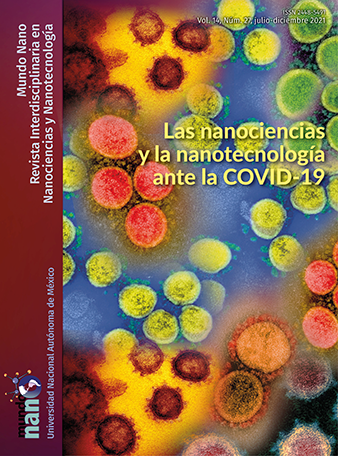Biosynthesis of gold nanoparticles (AuNPs) and the reducing agents in the process
Contenido principal del artículo
Resumen
Metallic nanoparticles (NPs) are being used mainly because they have excellent physical, chemical and biological properties, intrinsic to their size, therefore there is a boom in the use of these nanoparticles in various fields and recently, due to the pandemic about coronavirus. Copper NPs began to be used for use in medical supplies such as face masks. NPs are normally obtained through inorganic synthesis, however, the methodologies used to obtain them are in general terms expensive and involve the use of hazardous chemicals, which has increased the development of sustainable and environmentally friendly alternatives, as one of the main objectives of nanotechnology. Considering that nanoparticle biosynthesis is of greatest importance since it allowed obtaining organic NPs through an environmentally friendly; quick and inexpensive.
In this work, the synthesis and characterization of AuNPs of six different plant extracts that in traditional medicine are used for respiratory diseases care, were performed. These NPs can be used in different fields; even they represent a good option to be added to medical supplies. As the AuNPs obtained from chamomile extract that turned out to be spherical, 20 nm in diameter, and well dispersed, these could be applied orally, as nanocapsules that are easily eliminated from the human body, or by aerosol, as a possible treatment for the pneumonia and SARS-CoV-2, in addition later for other nosocomial diseases. And to answer the question of what or which reducing agents are involved in the process? We proposed that, for biological synthesis, malic acid may be acting as a reducing agent and the amino group as a stabilizing agent, so we performed a synthesis with malic acid and obtained stable NPs. However, we do not dismiss other metabolites enzymes and/or proteins that could be involved in the process.
Detalles del artículo

Mundo Nano. Revista Interdisciplinaria en Nanociencias y Nanotecnología, editada por la Universidad Nacional Autónoma de México, se distribuye bajo una Licencia Creative Commons Atribución-NoComercial 4.0 Internacional.
Basada en una obra en http://www.mundonano.unam.mx.
Citas
Abrica-González, P., Zamora-Justo, J. A., Chávez-Sandoval, B. E., Vázquez-Martínez, G. R., Balderas-López, J. A. (2018), Measurement of the optical properties of gold colloids by photoacoustic spectroscopy. International Journal of Thermophysics, ICPPP 19. https://doi.org/10.1007/s10765-018-2412-1
Agaoglu, S., Dostbil, S. and Alemdar, S. (2007). Antimicrobial activity of some spices used in the meat industry. Bull Vet Inst Pulawy, 51: 53-57.
Castillo-Juárez, I., García-Contreras, R., Velázquez-Guadarrama, N., Soto-Hernández, M., Martínez-Vázquez, M. (2013). Amphypterygium adstringens anacardic acid mixture inhibits quorum sensing-controlled virulence factors of Chromobacterium violaceum and Pseudomonas aeruginosa. Arch Med Res. 44(7): 488-94. https://doi.org/10.1016/j.arcmed.2013.10.004
Celis, L. (2010). Usos medicinales del clavo de olor Syzygium aromaticum (L.) (Merr. et Perry). México: Tlahui. Medicina tradicional mexicana.
Chávez-Sandoval, B. E., Balderas-López, J. A., Padilla-Bernal, G., Moreno-Rivera, M. L., Franco-Hernández, M. O., Martínez-Jiménez, A. and García-Franco, F. (2015). Photopyroelectric techniques for thermo-optical characterization of gold nano-particles. Journal of Physics: Conference Series, 582: 012027, IOP Science.
https://doi.org/10.1088/1742-6596/582/1/012027
Chávez-Sandoval, B. E., Ibáñez-Hernández, M. A. A., García-Franco, F., Galindo-Pérez, E. J., Abrica-Gónzalez, P., Martínez-Jiménez, A. Balderas-López, J. A. (2016). Biological synthesis and characterization of gold nanoparticles
(AuNPs), using plant extracts. Journal of Nanomaterials & Molecular Nanotechnology, 5(4). http://dx.doi.org/10.4172/2324-8777.1000192
Chávez-Sandoval, B. E., Balderas-López, J. A., García-Franco, F., Galindo Pérez, E. J., Martínez-Jiménez, A., Ibáñez Hernández, M. A. A. (2020). The role of pH in the synthesis, distribution and potential applications of gold nanoparticles. International Journal of Biomedical Nanoscience and Nanotechnology, 4(1/2): 120-138. https://doi.org/10.1504/IJBNN.2020.10029083
De la Fuente, P., Chamorro, P., Moreno, M. Poza, M. (2004). Propiedades antioxidantesdel hidroxitirosol procedente de la hoja de olivo (Olea europea). Revistade Fitoterapia, 4(2): 139-147.
Fujimori, Y., Sato, T., Hayata, T., Nagao, T., Nakayama, M., Nakayama, T., Sugamata,R., Suzukic, K. (2012). Novel antiviral characteristics of nanosized copper (I)Iodide particles showing inactivation activity against 2009 pandemic H1N1Influenza virus. Applied and Environmental Microbiology, 78(4): 951-955. https://doi.org/10.1128/AEM.06284-11
Hu, T., Frieman, M., Wolfram, J. (2020). Insights from nanomedicine into chloroquine efficacy against Covid-19. Comment. https://doi.org/10.1038/s41565-020-0674-9
Khan, T., Ullah, N., Khan, M., Mashwani, Z., Nadhman, A. (2019). Plant-based gold nanoparticles; a comprehensive review of the decade-long research on synthesis, mechanistic aspects and diverse applications. Adv Colloid Interface Sci. 272: 102017. https://doi.org/10.1016/j.cis.2019.102017
Kim, B., Rutka, J., Chan, W. (2010). The new England journal of medicine. 16; 363(25): 2434-43. https://doi.org/10.1056/NEJMra0912273
Liu, Q., Meng, X., Li, Y., Zhao, C., Tang, G. and Li, H. (2017) Antibacterial and antifungal activities of spices. Int J Mol Sci. 18(6). https://doi.org/10.3390/ijms18061283
Lerchundi, A. M. (2006). Líquenes medicamentosos. http://www.acfah.org/privado/apuntes/1-liq-med.pdf [24th April 2020].
Morales, R. and Pardo de Santayana, M. (2006). Manzanillas ibéricas: historia y usos tradicionales. Revista de Fitoterapia, 6(2):143-153.
Panda, T. and Deepa, K. (2011). Biosynthesis of gold nanoparticles. J Nanosci Nanotechnol. 11(12): 10279-94. https://doi.org/10.1166/jnn.2011.5021
Rico-Moctezuma, A., Vilchis-Néstor, A., Sánchez-Mendieta, V. (2010). Biosíntesis de nanopartículas de oro mediante el extracto de Opuntia ficus-indica. Superficies y Vacío, 23(S): 94-97. SV23S9410.pdf
Rodríguez-García, A., Peixoto, I. T. A.,Verde-Star, M. J., De la Torre-Zavala, S., Aviles-Arnaut, H. and Ruiz, A. L. T. G. (2015). In vitro antimicrobial and antiproliferative activity of Amphipterygium adstringens. Hindawi Publishing Corporation, Evidence-Based Complementary and Alternative Medicine. Article ID 175497, P.7. https://doi.org/10.1155/2015/175497
Rojas Rodríguez, F. (2007). Árboles que curan: el noni. Kurú. Revista Forestal, 4(10):4. Costa Rica.
Shitan, N. and Yazaki, K. (2013). New insights into the transport mechanisms in plant vacuoles. Int Rev Cell Mol Biol, 305: 383-433. https://doi.org/10.1016/B978-0-12-407695-2.00009-3
Shitan, N., Dalmas, F., Dan, K., Kato, N., Ueda, K., Sato, F., Forestier, C., Yasaki, K. (2013). Characterization of Coptis japónica CjABCB2, an ATP-binding cassette protein involved in alkaloid transport. Phytochemistry, 91: 109-116.
https://doi.org/10.1016/j.phytochem.2012.02.012
Torres Peydró, A., Toranzo Reyes, A. (2006). Morinda citrifolia (Tahitian Noni). History, current studies about its medical use. Review. Departamento de Estomatología Infantil. Unidad Docente de Estomatología. Universidad Médica Mariana Grajales Coello. Holguín, Cuba.





